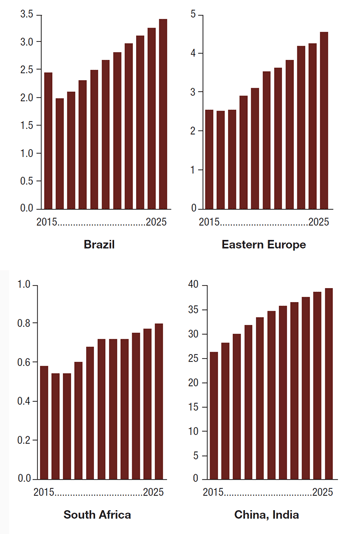Report highlights forces driving the future of the global automotive industry
October 4, 2016
PricewaterhouseCoopers (PwC), the global financial services specialist, recently published its forecast for the challenges facing the global automotive industry. In its Stategy& 2016 Auto Industry Trends, PwC stated that global macroeconomic forces, a new era of personal transportation and stricter regulations would all impact the automotive sector to 2025.

Emerging markets are expected to show consistent growth in light vehicle sales in the next decade
In terms of the key geographic regions PwC forecasts Mexico to have a significant impact on North American vehicle production and sales, particularly in the U.S. The U.S. markets peaked at historic high levels in 2015, setting a sales record of just under 17.5 million, up 5.7% from the year before and topping the high-water mark of 17.4 million achieved in 2000. However, PwC forecasts U.S. sales to be relatively flat in the next two years and may face a moderate downturn in 2018.
Investments in new auto factories in Mexico are surging states PwC; installed capacity is likely to grow more than 50% over the next five years (partially for North American consumption, but also for global export). These conditions compel automakers and suppliers to manage supply chains and factory usage cautiously in the U.S., while continuing to expand in Mexico. Mexican auto sales outpaced forecasts in 2015, jumping 19% to more than 1.3 million units, and are expected to surpass 1.5 million by 2021.
For the European Union (EU) PwC states that whilst auto sales have improved since the economic downturn, the EU’s automotive industry is held hostage by national economies that are said to be teetering on the edge of recession. Auto producers in France, Greece, Spain, Italy, and Portugal are said to face losses or low profits, fragmented markets, and the inefficiencies of model proliferation.
PwC reports that the E.U. auto industry must figure out ways to better match production capacity to market demand, while simultaneously investing in new potentially strong product areas (for example, small SUVs and crossovers) and in new automobile technologies. In 2015, new car registrations in the E.U. rose 9.3% year-on-year, to 12.6 million units. However, that is well below the record year of 2007, when more than 18 million vehicles were sold in the region.
PwC states that there have been mixed results in emerging nations such as India, China, Russia and Brazil with the latter seeing sales fall by nearly 30%, or 1.3 million units, from its high in 2012, a drop that was said to be larger than the entire Mexican car market.
China’s growth has been slowing but is still a healthy 7.3% and automakers have made massive investments in the country. China is now the world’s largest auto market and vehicle sales and production are forecast to rise to more than 30 million units by 2020.
Underperformance of car sales in the emerging markets was also underlined by the precipitous decline of Russia’s car sales over the past two years which has seen an almost 50% decline since 2012. India’s sales have remained roughly flat in 2015,
PwC forecasts that over the next five years the Middle East and Africa (ME&A) region will likely see strong growth with the biggest improvements expected in Iran, Egypt, South Africa and Nigeria. According to PwC Autofacts® nearly three million cars will be built annually in ME&A, an output increase of around 50%. However, given the diversity of this region — PwC states that there are more than fifty distinct markets — automakers face the obstacle of satisfying multiple unique local requirements in order to thrive.
PwC further stated that although many people will be drawn to electric vehicles and autonomous cars, the traditional powertrains and internal combustion engines are more than likely to be the predominant type of vehicle on the road for decades to come. Stricter regulations will make automakers focus not only on upgrading the transportation and mobility features of their vehicles, but they will also need to meet the stricter fuel economy regulations which by 2025 will have to average upward of 60 miles per gallon in European and US cars.
PwC states that meeting these standards will require step-change advances and improvements, not incremental ones. Also, considering the short time frame, many of these advances will have to be applied to the traditional internal combustion engine and powertrain. Industry experts believe that petroleum-based vehicle fuel economy can be improved by as much as 75% with combustion breakthroughs focused on maximizing engine efficiency and minimizing the formation of emissions within engine cylinders; exhaust after treatment technologies that further reduce emissions; and the recovery of energy from waste heat.
Some automakers, including BMW, Mazda and Fiat Chrysler, are attempting to meet stricter fuel economy standards through a combination of improved aerodynamics, better performance using turbo engines, and lighter manufacturing materials, among other tactics, says PwC. Honda and other Japanese car makers are adopting continuously variable transmissions (CVTs) across the bulk of their car line-ups. Instead of cycling through fixed gears, these automatic transmissions operate on pulleys that constantly adjust gear ratios to provide optimal performance in transferring power to the automobile’s wheels. CVT technology delivers much better fuel economy because it eliminates inherent inefficiencies in fixed-gear transmissions that result in wasted energy.















